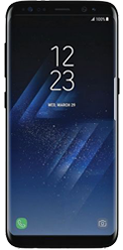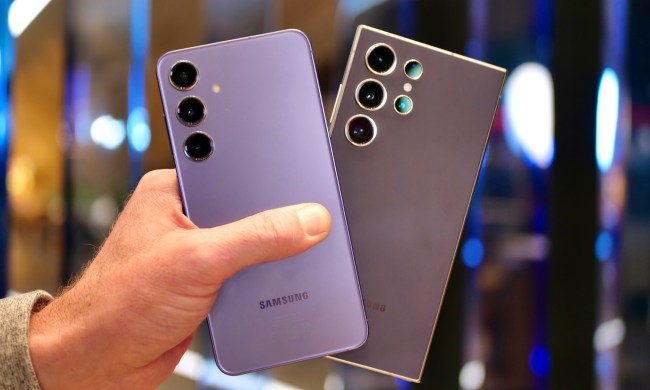
The Google Pixel may be a few months old now, but that doesn’t mean it can’t hold its own. How do the two phones compare? We put their specs head to head to find out.
Specs
Google Pixel |
Samsung Galaxy S8 |
|
| Size | 143.8 x 69.5 x 7.3mm (5.6 x 2.7 x 0.2-0.3-inches) | 148.9 x 68.1 x 8.0mm (5.9 x 2.7 x 0.3-inches) |
| Weight | 143g (5.0 oz) | 155g (5.5oz) |
| Screen | 5.0-inch AMOLED | 5.8-inch AMOLED |
| Resolution | 1,080 x 1,920 pixels (441 pixels per inch) | 2,960 x 1,440 pixels (570ppi) |
| OS | Android 7.1 Nougat | Android 7.0 Nougat |
| Storage | 32/128GB | 64GB |
| MicroSD card slot | No | Yes |
| NFC support | Yes | Yes |
| Processor | Qualcomm Snapdragon 821 | Qualcomm Snapdragon 835 Samsung Exynos 9 Series 8895 (International) |
| RAM | 4GB | 4GB |
| Connectivity | GSM / CDMA / HSPA / LTE | GSM / CDMA / HSPA / LTE |
| Camera | 12MP rear, 8MP front | 12MP rear with OIS, 8MP front |
| Video | 2,160p at 30fps | 2,160p at 30fps |
| Bluetooth | Yes, version 4.2 | Yes, version 5.0 |
| Fingerprint sensor | Yes | Yes |
| Other sensors | Accelerometer, gyro, proximity, barometer | Accelerometer, gyro, proximity, compass, barometer, heart rate, iris scanner |
| Water resistant | No | IP68 |
| Battery | 2,770mAh | 3,000mAh |
| Ports | USB-C, headphone jack | USB-C, headphone jack |
| Marketplace | Google Play | Google Play |
| Color offerings | Very Silver, Quite Black, Really Blue | Black, silver, orchid grey, blue (international), gold (international) |
| Availability | Google Play, Verizon | April 21 |
| Price | Starts at $650 | Starts at $720 |
| DT review | 4 out of 5 stars | First take |
In the specs department, there’s unsurprisingly a clear winner.
When the Google Pixel was released, it featured a top-of-the-line Qualcomm Snapdragon 821 processor, a chip that was the best choice available to Google at the time. Months later, Qualcomm’s out with a new, better chip: The Snapdragon 835. We don’t yet know exactly how much better the Snapdragon 835 performs compared to the Snapdragon 821, but early benchmark results indicate the new chip is a good 20 percent or more than its predecessor.
Processor performance isn’t the only thing to consider here — but it is perhaps most important. Both phones offer 4GB of RAM. but when it comes to internal storage the Google Pixel offers options of either 32GB or 128GB, while you only have a choice of 64GB on the Galaxy S8 sits in at 64GB. The base model of the Galaxy S8 offers more than the base model of the Pixel, but what’s more is the Galaxy S8 offers a MicroSD card slot, so you can expand on your storage by up to 256GB.
Considering the fact the Galaxy S8 has a much better processor, the better performing device is unsurprisingly the Samsung Galaxy S8.
Winner: Samsung Galaxy S8
Design and display
Both the Pixel and the Galaxy S8 have unique designs. The Pixel’s half-glass back makes it easily distinguishable, though the bezels on the front surrounding the AMOLED display aren’t pretty. It offers a standard 1,920 x 1,080 pixel resolution, which looks great on the 5-inch phone.
The Galaxy S8 goes several steps further, however, as it offers a unique Infinity Display, which not only has a higher 2,960 x 1,440 pixel resolution, but ultra-thin bezels. In fact, despite the large 5.8-inch screen, the Galaxy S8 is almost as compact as the Pixel thanks to the minimal bezels and curved Edge AMOLED display.
The Galaxy S8 also has a super-sleek glass backing, though the design isn’t too different from prior Samsung phones. The Google Pixel’s half-glass back drew mixed reviews.
Design is largely subjective, but there’s no denying that Samsung’s Infinity Display helps it come out on top in terms of design and a vibrant, colorful display.
Winner: Samsung Galaxy S8
Battery life and charging
Battery life isn’t always as black-and-white as a figure on paper. The Google Pixel offers a battery capacity of 2,770mAh, which is okay for a phone of its size. The Galaxy S8 packs a decently-larger, 3,000mAh battery, but it also has a more power-intensive display that could suck up the battery more.
Still, the Snapdragon 835 processor is supposedly more efficient, according to Qualcomm, and we’re expected to see battery improvements thanks to the chip. We’ll have to wait and see how that claim holds up, but Samsung also wins points for its support for wireless charging.
Both devices support some form of fast-charging technology, but that’s not enough for the Pixel to beat Samsung this round.
Winner: Samsung Galaxy S8
Camera

The camera is an increasingly important part of a smartphone’s use — nowadays, most people use their phone as their primary camera, and each year smartphone cameras get closer and closer to even being appropriate for professional use. The Google Pixel is an excellent example of this — when the device was unveiled, Google touted it has having one of the best smartphone cameras ever, and it was a claim that stood up in reviews.
More: We took the Google Pixel and iPhone 7 Plus to France for an epic camera shootout
When it comes to raw specs, the Google Pixel offers a 12-megapixel rear-facing camera with an f/2.0 aperture and Electronic Image Stabilization, or EIS. Not only that, but it also has 1.55 micron pixels — which are a little larger than normal, and make for great low-light photos. The front-facing camera packs 8 megapixels.
Samsung didn’t change much with its camera setup on the Galaxy S8 — it has the same dual-pixel 12-megapixel rear camera as the Galaxy S7, and the only improvement is to the front-facing camera, which now also packs 8 megapixels like the Pixel.
Samsung hardly touted its rear camera, so it’s unlikely we’ll see much of a difference from the Galaxy S7. In our tests, the Pixel outperformed the Galaxy S7, so we’ll have to grant it the winning title here.
Winner: Google Pixel
Software
Both phones may run Android, but that doesn’t mean the software experience is the same. The Pixel takes over from the Nexus program in offering Android as Google intended it. That’s to say, the Pixel offers stock Android, with little to no bloatware.
Samsung, on the other hand, is known for bundling in its own services and features. For many, that’s a good thing — and there’s nothing to say that Samsung’s features are better or worse than Google’s — but if you’re looking for something simple and basic, then the software experience on the Pixel will likely suit you a little better than that on the Galaxy S8.
The Galaxy S8 features Samsung’s new personal assistant, Bixby, but you can also use Google Assistant, a voice assistant used in the Pixel and now many other big Android phones. The jury’s still out on Bixby, but limited app support doesn’t make it seem appealing at the moment.
More: Samsung DeX dock: Our first take
Still, Samsung does have the leg up with Samsung Pay, which works are more locations than Android Pay. You can also use the Galaxy S8 with Samsung’s new DeX dock, which can plug into a monitor to offer a desktop, Android experience.
But where the Galaxy S8 falls short is where the Pixel excels — software and security updates. Samsung has poor history in updating its phones in a timely fashion, so you should expect Android version updates quite a few months after Google releases it. The same applies for more important monthly security updates, though Samsung is promising to do better.
Updates are important, as it keeps your phone safe and ensures longevity. That alone wins the software competition for the Pixel.
Winner: Google Pixel
Durability

Phones should last at least a few years, and during that time it’s likely they’ll take a drop or two, and perhaps see some water damage. In other words, the more durable a phone is, the better. The Google Pixel isn’t exactly renowned for its durability — the glass on the front or back likely won’t survive a drop. But the same can be said for the Galaxy S8, and it could be even worse.
The Galaxy S8 is pretty much covered front and back with glass, and the curved display is also problematic. A larger display surface area means that a phone is more likely to land awkwardly and crack.
But the Galaxy S8 still wins in terms of durability, because it has a water-resistance rating of IP68, meaning the phone is dust-proof and can withstand being submerged in up to 1.5m of water for up to 30 minutes.
Both phones are easily to break from accidental drops, but at least Samsung has your back in the water.
Winner: Samsung Galaxy S8
Price and availability
The Google Pixel has been out for a while now, however it’s still only available through Verizon or unlocked through the Google Store. The phone starts at $650 for the 32GB variant, or if you want to get the 128GB version, you’ll need to shell out $750. Unfortunately, Google has been having inventory issues, so don’t expect to nab the phone quickly — you’ll have to wait a while.
The Samsung Galaxy S8 isn’t available just yet, but you can preorder it now with full availability on April 21. Here’s a comparison of carrier pricing and availability:
| Google Pixel | Samsung Galaxy S8 | |
| AT&T | N/A | $750 or $25 per month for 30 months |
| Sprint | N/A | $750 or $31.25 per month for 24 months |
| T-Mobile | N/A | $750 or $30 per month for 24 months with a $30 down payment |
| Verizon | $650 or $27.08 per month for 24 months | $720 or $30 per month for 24 months |
The Galaxy S8 may be a little more expensive, but at least you won’t have trouble purchasing the device.
Winner: Samsung Galaxy S8
Overall winner: Samsung Galaxy S8
Perhaps unsurprisingly, the winner here is the Samsung Galaxy S8. The device is not only more powerful, but it also has a better display, better battery, and it has cool extra features like the ability to use the DeX dock. That’s not to say the Google Pixel isn’t a good phone — it’s an excellent one. But the newer Samsung Galaxy S8 is the phone to beat for the year.







